![]()
![]()
![]()
Use LEFT and RIGHT arrow keys to navigate between flashcards;
Use UP and DOWN arrow keys to flip the card;
H to show hint;
A reads text to speech;
333 Cards in this Set
- Front
- Back

|

|
|
|
Address client by name and introduces self to client by name.
|
Wash Hands 1
|
|
|
Turn on water at sink.
|
Wash Hands 2
|
|
|
Wet hands and wrists thoroughly.
|
Wash Hands 3
|
|
|
Apply soap to hands.
|
Wash Hands 4
|
|
|
Critical Step:
Lather all surfaces of wrists, hands, and fingers, producing friction for at least 15 seconds. |
Wash Hands 5
|
|
|
Clean fingernails by rubbing fingertips against palms of the opposite hand.
|
Wash Hands 6
|
|
|
After lathering for 15 seconds, rinse all surfaces of wrists, hands, and fingers keeping hands lower than elbows and fingertips down.
|
Wash Hands 7
|
|
|
Use clean, dry paper towel to dry all surfaces of hands, wrists, and fingers then dispose of paper towel into waste container.
|
Wash Hands 8
|
|
|
Use clean, dry paper towel to turn of faucet then dispose of paper towel into waste container.
|
Wash Hands 9
|
|
|
Do not touch inside of sink at any time.
|
Wash Hands 10
|
|

|

|
|
|
Explain procedure, speaking clearly, slowly, and directly, maintaining face-to-face contact whenever possible.
|
Apply One Knee-High Stocking 1
|
|
|
Provide privacy with a curtain, screen or door.
|
Apply One Knee-High Stocking 2
|
|
|
Client is in supine position while stocking is applied.
|
Apply One Knee-High Elastic Stocking 3
|
|
|
Turn stocking inside out.
|
Apply One Knee-High Elastic Stocking 4
|
|
|
Place foot of stocking over toes, foot, and heel.
|
Apply One Knee-High Elastic Stocking 5
|
|
|
Pull top of stocking over toes, foot and heel.
|
Apply One Knee-High Elastic Stocking 6
|
|
|
Move foot and leg gently and naturally, avoiding force and over-extension of limb and joints.
|
Apply One Knee-High Elastic Stocking 7
|
|
|
Critical Step: Finish procedure with no twists or wrinkles and heel of stocking (if present) is over heel and opening in toe area (if present) is either over or under toe area.
|
Apply One Knee-High Elastic Stocking 8
|
|
|
Make sure signaling device is within reach.
|
Apply One Knee-High Stocking 9
|
|
|
Wash hands.
|
Apply One Knee-High Stocking
|
|
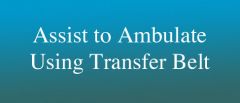
|

|
|
|
Explain procedure, speaking slowly, and directly, maintaining face-to-face contact whenever possible.
|
Assist to Ambulate Using Transfer Belt 1
|
|
|
Before assisting to stand, bed is at a safe level.
|
Assist to Ambulate Using Transfer Belt 3
|
|
|
Critical step: Before assisting to stand, candidate ensures client is wearing shoes.
|
Assist to Ambulate Using Transfer Belt 2
|
|
|
Before assisting to stand, check and/or lock bed wheels.
|
Assist to Ambulate Using Transfer Belt 4
|
|
|
Before assisting to stand, provide instructions to enable client to assist in standing including prearranged signal to alert client to begin standing.
|
Assist to Ambulate Using Transfer Belt 7
|
|
|
Before assisting to stand, assist client to sitting position with feet flat on floor.
|
Assist to Ambulate Using Transfer Belt 5
|
|
|
Stand facing client positioning self to ensure your own safety and client's safety during transfer. Count to three or say other prearranged signal to alert client to begin standing.
|
Assist to Ambulate Using Transfer Belt 8
|
|
|
On signal, gradually assist client to stand by grasping transfer belt on both sides with upward grasp (your hands in upward position), and maintain stability of client's legs.
|
Assist to Ambulate Using Transfer Belt 9
|
|
|
Before assisting to stand, apply transfer belt securely over clothing/gown.
|
Assist to Ambulate Using Transfer Belt 6
|
|
|
Walk slightly behind and to one side of client for a distance of 10 feet, while holding onto the belt.
|
Assist to Ambulate Using Transfer Belt 10
|
|
|
After ambulation, assist client to bed and remove transfer belt.
|
Assist to Ambulate Using Transfer Belt 11
|
|
|
Ensure signaling device is within reach and bed is in low position.
|
Assist to Ambulate Using Transfer Belt 12
|
|
|
Wash hands.
|
Assist to Ambulate Using Transfer Belt 13
|
|

|

|
|
|
Explain procedure, speaking slowly and directly, maintainng face-to-face contact whenever possible.
|
Assist With Use of Bedpan 1
|
|
|
Provide privacy with a curtain, screen or door.
|
Assist With Use of Bedpan 2
|
|
|
Before placing bedpan, lowers head of bed.
|
Assist With Use of Bedpan 3
|
|
|
Before handling bedpan, put on clean gloves.
|
Assist With Use of Bedpan 4
|
|
|
Critical step: Place bedpain correctly under client's buttocks.
|
Assist With Use of Bedpan 5
|
|
|
Remove and dispose of gloves (without contaminating self) into waste container and wash hands.
|
Assist With Use of Bedpan 6
|
|
|
Ensure toilet paper is within reach.
|
Assist With Use of Bedpan 8
|
|
|
After positioning client on bedpan and removing gloves, raise head of bed.
|
Assist With Use of Bedpan 7
|
|
|
Ensure hand wipe is within reach and instruct client to clean hands with hand wipe when finished.
|
Assist With Use of Bedpan 9
|
|
|
Put on clean gloves before removing bedpan.
|
Assist With Use of Bedpan 11
|
|
|
Ensure signaling device is within reach and instruct client to signal when finished.
|
Assist With Use of Bedpan 10
|
|
|
Avoid overexposure of client.
|
Assist With Use of Bedpan 13
|
|
|
Flatten head of bed before removing bedpan.
|
Assist With Use of Bedpan 12
|
|
|
Remove, empty and rinse bedpan and posit rinse into toilet.
|
Assist With Use of Bedpan 14
|
|
|
After rinsing bedpan, place bedpan in designated dirty supply area.
|
Assist With Use of Bedpan 15
|
|
|
After placing bedpan in designated dirty supply area, remove and dispose of gloves (without contaminating self) into waste container and wash hands.
|
Assist With Use of Bedpan 16
|
|
|
Ensure signaling device is within reach and bed is in low position.
|
Assist With Use of Bedpan 17
|
|

|

|
|
|
Before handling dentures, put on clean gloves.
|
Clean Upper or Lower Denture 1
|
|
|
Before holding denture over sink, line sink and/or partially fill it with water.
|
Clean Upper or Lower Denture 2
|
|
|
Before brushing denture, rinse it in tepid temperature running water.
|
Clean Upper or Lower Denture 3
|
|
|
Apply toothpaste to toothbrush.
|
Clean Upper or Lower Denture 4
|
|
|
Brush surfaces of denture.
|
Clean Upper or Lower Denture 5
|
|
|
Before placing denture into cup, rinse denture cup and lid.
|
Clean Upper or Lower Denture 7
|
|
|
Rinse surfaces of denture under tepid temperature running water.
|
Clean Upper or Lower Denture 6
|
|
|
Place denture into cup with tepid water temperature and place lid on cup.
|
Clean Upper or Lower Denture 8
|
|
|
Rinse toothbrush and place in designated toothbrush basin/container.
|
Clean Upper or Lower Denture 9
|
|
|
Maintain clean technique with placement of toothbrush and denture.
|
Clean Upper or Lower Denture 10
|
|
|
Remove sink liner and dispose it appropriately and/or drain sink.
|
Clean Upper or Lower Denture 11
|
|
|
After rinsing equipment and disposing of sink liner, remove and dispose of gloves (without contaminating self) into waste container and wash hands.
|
Clean Upper or Lower Denture 12
|
|

|

|
|
|
Explain procedure, speaking slowly, clearly and directly, maintaining face-to-face contact whenever possible.
|
Count and Record Radial Pulse 1
|
|
|
Place fingertips on thumb side of client's wrist to locate radial pulse.
|
Count and Record Radial Pulse 2
|
|
|
Count beats for one full minute.
|
Count and Record Radial Pulse 3
|
|
|
Ensure signaling device is within reach.
|
Count and Record Radial Pulse 4
|
|
|
Wash hands.
|
Count and Record Radial Pulse 5
|
|
|
Critical step: After obtaining pulse by palpating in radial artery position, record pulse within plus or minus 4 beats of evaluator's reading.
|
Count and Record Radial Pulse 6
|
|

|

|
|
|
Explain procedure (for testing purposes), speaking clearly, slowly and directly, maintaining face-to-face contact whenever possible.
|
Count and Record Respirations 1
|
|
|
Count respirations for one minute.
|
Count and Record Respirations 2
|
|
|
Ensure signaling device is within reach.
|
Count and Record Respirations 3
|
|
|
Wash hands.
|
Count and Record Respirations 4
|
|
|
Critical step: Record respiration rate within plus or minus 2 breaths of evaluator's reading.
|
Count and Record Respirations 5
|
|

|

|
|
|
Pick up gown and unfold it.
|
Don and Remove PPE (Gown and Gloves) 1
|
|
|
Facing the back opening of the gown, place arms through each sleeve.
|
Don and Remove PPE (Gown and Gloves) 2
|
|
|
Fasten the neck opening.
|
Don and Remove PPE (Gown and Gloves) 3
|
|
|
Secure gown at waist making sure that back of clothin is covered by gown as much as possible.
|
Don and Remove PPE (Gown and Gloves) 4
|
|
|
Put on gloves.
|
Don and Remove PPE (Gown and Gloves) 5
|
|
|
Ensure cuffs of gloves overlap cuffs of gown.
|
Don and Remove PPE (Gown and Gloves) 6
|
|
|
With one gloved hand, grasp the other glove at the palm, pulling it off.
|
Don and Remove PPE (Gown and Gloves) 7
|
|
|
Slip fingers from ungloved hand underneath cuff of remaining glove at wrist, removing glove, turning it inside out as it is removed.
|
Don and Remove PPE (Gown and Gloves) 8
|
|
|
Dispose of glove into designated waster container without contaminating self.
|
Don and Remove PPE (Gown and Gloves) 9
|
|
|
After removing gloves, unfasten gown at neck and waist.
|
Don and Remove PPE (Gown and Gloves) 10
|
|
|
While removing gown, hold gown away from body, turning gown inward and keeping it inside out.
|
Don and Remove PPE (Gown and Gloves) 12
|
|
|
Remove gown without touching outside of gown.
|
Don and Remove PPE (Gown and Gloves) 11
|
|
|
Dispose of gown into designated container without contaminating self.
|
Don and Remove PPE (Gown and Gloves) 13
|
|
|
Wash hands.
|
Don and Remove PPE (Gown and Gloves) 14
|
|

|

|
|
|
Explain procedure, speaking clearly, slowly and directly, maintaining face-to-face contact whenever possible.
|
Dresses Client With Affected (Weak) Right Arm 1
|
|
|
Provide privacy with a curtain, screen or door.
|
Dresses Client With Affected (Weak) Right Arm 2
|
|
|
Ask client which top he/she would like to wear and dress him/her in that top.
|
Dresses Client With Affected (Weak) Right Arm 3
|
|
|
While avoiding overexposure of client, remove gown from the unaffected side first, then from the affected side.
|
Dresses Client With Affected (Weak) Right Arm 4
|
|
|
Critical step: Assist client in putting the right (affected/weak) arm through the right sleeve of the top before placing garment on left (unaffected) arm.
|
Dresses Client With Affected (Weak) Right Arm 5
|
|
|
While putting on items, move body gently and naturally, avoiding force and over-extension of limbs and joints.
|
Dresses Client With Affected (Weak) Right Arm 6
|
|
|
Finish with clothing in place.
|
Dresses Client With Affected (Weak) Right Arm 7
|
|
|
Dispose of gown into soiled linen container.
|
Dresses Client With Affected (Weak) Right Arm 8
|
|
|
Ensure signaling device is within reach and bed is in low position.
|
Dresses Client With Affected (Weak) Right Arm 9
|
|
|
Wash hands.
|
Dresses Client With Affected (Weak) Right Arm 10
|
|

|

|
|
|
Explain procedure, speaking clearly, slowly and directly, maintaining face-to-face contact whenever possible.
|
Feed Client Who Cannot Feed Self 1
|
|
|
Before feeding client, pick up name card from tray and ask client to state name.
|
Feed Client Who Cannot Feed Self 2
|
|
|
Critical step: Before feeding client, place client in an upright sitting position (45 to 90°).
|
Feed Client Who Cannot Feed Self 3
|
|
|
Place tray where it can be easily seen by client.
|
Feed Client Who Cannot Feed Self 4
|
|
|
Clean client's hands with hand wipe before beginning feeding.
|
Feed Client Who Cannot Feed Self 5
|
|
|
Sit facing client during feeding.
|
Feed Client Who Cannot Feed Self 6
|
|
|
Tell client what foods are on tray and ask what client would like to eat first.
|
Feed Client Who Cannot Feed Self 7
|
|
|
Using spoon, offer client one bit of each type of food on tray, telling client the content of each spoonful.
|
Feed Client Who Cannot Feed Self 8
|
|
|
Offer beverage at least once during meal.
|
Feed Client Who Cannot Feed Self 9
|
|
|
Make sure client's mouth is empty before offering next bite of food or sip of beverage.
|
Feed Client Who Cannot Feed Self 10
|
|
|
At end of meal, wipe client's mouth and hands with hand wipe.
|
Feed Client Who Cannot Feed Self 11
|
|
|
Remove food tray and place tray in designated dirty supply area.
|
Feed Client Who Cannot Feed Self 12
|
|
|
Ensure signaling device is within reach.
|
Feed Client Who Cannot Feed Self 13
|
|
|
Wash hands.
|
Feed Client Who Cannot Feed Self 14
|
|
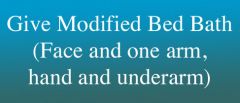
|

|
|
|
Explain procedure, speaking clearly, slowly and directly, maintaining face-to-face contact whenever possible.
|
Give Modified Bed Bath (Face and One Arm, Hand and Underarm) 1
|
|
|
Provide privacy with a curtain, screen or door.
|
Give Modified Bed Bath (Face and One Arm, Hand and Underarm) 2
|
|
|
Remove gown while keeping client covered.
|
Give Modified Bed Bath (Face and One Arm, Hand and Underarm) 3
|
|
|
Before washing client, check water temperature and ask client to verify comfort of water.
|
Give Modified Bed Bath (Face and One Arm, Hand and Underarm) 4
|
|
|
Before washing client, put on clean gloves.
|
Give Modified Bed Bath (Face and One Arm, Hand and Underarm) 5
|
|
|
Beginning with eyes, wash eyes with wet washcloth (no soap), using a different area of the washcloth for each eye, washing inner aspect then proceed to face.
|
Give Modified Bed Bath (Face and One Arm, Hand and Underarm) 6
|
|
|
Dry face with towel.
|
Give Modified Bed Bath (Face and One Arm, Hand and Underarm) 7
|
|
|
Expose one arm and place towel underneath arm.
|
Give Modified Bed Bath (Face and One Arm, Hand and Underarm) 8
|
|
|
Apply soap to wet washcloth.
|
Give Modified Bed Bath (Face and One Arm, Hand and Underarm) 9
|
|
|
Wash arm, hand and underarm, keeping rest of body covered.
|
Give Modified Bed Bath (Face and One Arm, Hand and Underarm) 10
|
|
|
Rinse and dry arm, hand and underarm.
|
Give Modified Bed Bath (Face and One Arm, Hand and Underarm) 11
|
|
|
Move body gently and naturally, avoiding force and over-exertion of limbs and joints.
|
Give Modified Bed Bath (Face and One Arm, Hand and Underarm) 12
|
|
|
Put clean gown on client.
|
Give Modified Bed Bath (Face and One Arm, Hand and Underarm) 13
|
|
|
Empty, rinse and dry basin.
|
Give Modified Bed Bath (Face and One Arm, Hand and Underarm) 14
|
|
|
After rinsing basin, place basin in designated dirty supply area.
|
Give Modified Bed Bath (Face and One Arm, Hand and Underarm) 15
|
|
|
Dispose of used gown and linen into soiled linen container.
|
Give Modified Bed Bath (Face and One Arm, Hand and Underarm) 16
|
|
|
Avoid contact between candidate clothing and used linens.
|
Give Modified Bed Bath (Face and One Arm, Hand and Underarm) 17
|
|
|
After placing basin in designated dirty supply area, and disposing of used linen, remove and dispose of gloves (without contaminating self) and wash hands.
|
Give Modified Bed Bath (Face and One Arm, Hand and Underarm) 18
|
|
|
Ensure signaling device is within reach and bed is in low position.
|
Give Modified Bed Bath (Face and One Arm, Hand and Underarm) 19
|
|

|

|
|
|
Explain procedure, speaking clearly, slowly and directly, maintaining face-to-face contact whenever possible.
|
Make An Occupied Bed (Client Does Not Need Assistance to Turn) 1
|
|
|
Provide privacy with a curtain, screen or door.
|
Make An Occupied Bed (Client Does Not Need Assistance to Turn) 2
|
|
|
Before moving client, lower head of bed.
|
Make An Occupied Bed (Client Does Not Need Assistance to Turn) 3
|
|
|
Cover client with linens while linens are changed.
|
Make An Occupied Bed (Client Does Not Need Assistance to Turn) 4
|
|
|
Loosen top linen from the end of the bed.
|
Make An Occupied Bed (Client Does Not Need Assistance to Turn) 5
|
|
|
Raise side rail on side to which client will move and ask client to move toward raised side rail.
|
Make An Occupied Bed (Client Does Not Need Assistance to Turn) 6
|
|
|
Loosen bottom used linen on working side and move bottom used linen toward center of bed.
|
Make An Occupied Bed (Client Does Not Need Assistance to Turn) 7
|
|
|
Place and tuck in clean bottom linen or fitted bottom sheet on working side, tucking it in under client.
|
Make An Occupied Bed (Client Does Not Need Assistance to Turn) 8
|
|
|
Before going to the other side, ask client to move back onto client bottom linen.
|
Make An Occupied Bed (Client Does Not Need Assistance to Turn) 9
|
|
|
Raise side rail on working side, then go to other side of bed.
|
Make An Occupied Bed (Client Does Not Need Assistance to Turn) 10
|
|
|
Remove used bottom linen.
|
Make An Occupied Bed (Client Does Not Need Assistance to Turn) 11
|
|
|
Pull and tuck in clean bottom linen, finishing with bottom sheet free of wrinkles.
|
Make An Occupied Bed (Client Does Not Need Assistance to Turn) 12
|
|
|
Cover client with clean top sheet and remove bath blanket/used top sheet.
|
Make An Occupied Bed (Client Does Not Need Assistance to Turn) 13
|
|
|
Change pillowcase.
|
Make An Occupied Bed (Client Does Not Need Assistance to Turn) 14
|
|
|
Center linen and tuck it in at foot of bed.
|
Make An Occupied Bed (Client Does Not Need Assistance to Turn) 15
|
|
|
Avoid contact between candidate's clothing and used linen.
|
Make An Occupied Bed (Client Does Not Need Assistance to Turn) 16
|
|
|
Dispose of used linen into soiled linen container and avoid putting linen on floor.
|
Make An Occupied Bed (Client Does Not Need Assistance to Turn) 17
|
|
|
Ensure signaling device is within reach and bed is in low position.
|
Make An Occupied Bed (Client Does Not Need Assistance to Turn) 18
|
|
|
Wash hands.
|
Make An Occupied Bed (Client Does Not Need Assistance to Turn) 19
|
|

|
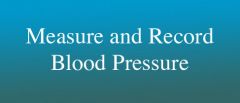
|
|
|
Explain procedure, speaking clearly, slowly and directly, maintaining face-to-face contact whenever possible.
|
Measure and Record Blood Pressure 1
|
|
|
Before using stethoscope, wipe bell-diaphragm and earpieces with alcohol.
|
Measure and Record Blood Pressure 2
|
|
|
Position client's arm with palm up and upper arm exposed.
|
Measure and Record Blood Pressure 3
|
|
|
Feel for brachial artery on inner aspect of arm, at bend of elbow.
|
Measure and Record Blood Pressure 4
|
|
|
Place blood pressure cuff snugly on client's upper arm, with sensor/arrow over brachial artery site.
|
Measure and Record Blood Pressure 5
|
|
|
Place earpieces of stethoscope into ears and place bell/diaphragm over brachial artery site.
|
Measure and Record Blood Pressure 6
|
|
|
Do one of the following: Inflate cuff between 160 mm Hg to 180 mm Hg. (If beat heard immediately upon cuff depletion, completely remove cuff.) -OR- Inflate cuff 30 mm Hg beyond where radial or brachial pulse was last heard or felt.
|
Measure and Record Blood Pressure 7
|
|
|
Deflate cuff slowly and note the first sound (systolic reading) and last sound (diastolic reading). (If rounding needed, measurements are rounded UP to the nearest 2 mm of mercury.)
|
Measure and Record Blood Pressure 8
|
|
|
Remove cuff.
|
Measure and Record Blood Pressure 9
|
|
|
Ensure signaling device is within reach.
|
Measure and Record Blood Pressure 10
|
|
|
Wash hands.
|
Measure and Record Blood Pressure 11
|
|
|
Critical step: After obtaining reading using BP cuff and stethoscope, record both systolic and diastolic pressures each within plus or minus 8 mm of evaluator's reading.
|
Measure and Record Blood Pressure 12
|
|

|

|
|
|
Put on clean gloves before handling bedpan.
|
Measure and Record Urinary Output 1
|
|
|
Pour the contents of the bedpan into measuring container without spilling or splashing urine outside of container.
|
Measure and Record Urinary Output 2
|
|
|
Measure the amount of urine at eye level with container on flat surface.
|
Measure and Record Urinary Output 3
|
|
|
After measuring urine, empty contents of measuring container into the toilet.
|
Measure and Record Urinary Output 4
|
|
|
Rinse measuring container and pour rinse into toilet.
|
Measure and Record Urinary Output 5
|
|
|
Rinse bedpan and pour rinse into toilet.
|
Measure and Record Urinary Output 6
|
|
|
After rinsing equipment and before recording output, remove and dispose of gloves (without contaminating self) into waste container and wash hands.
|
Measure and Record Urinary Output 7
|
|
|
Critical step: Record contents of container within plus or minus 25 ml/cc of evaluator's reading.
|
Measure and Record Urinary Output 8
|
|

|

|
|
|
Explain procedure, speaking slowly, clearly and directly, maintaining face-to-face contact whenever possible.
|
Measure and Record Weight of Ambulatory Client 1
|
|
|
Before walking to scale, ensure client has shoes on.
|
Measure and Record Weight of Ambulatory Client 2
|
|
|
Before weighing client, set scale to zero.
|
Measure and Record Weight of Ambulatory Client 3
|
|
|
As client steps onto scale, stand beside scale and assist client, if needed, onto scale center, then determine client's weight.
|
Measure and Record Weight of Ambulatory Client 4
|
|
|
As client steps off scale, stand beside scale and assist client, if needed, off scale before recording weight.
|
Measure and Record Weight of Ambulatory Client 5
|
|
|
Critical step: Record weight on indicator on scale. Weight must be within plus or minus 2 lbs or 0.9 kg of evaluator's reading.
|
Measure and Record Weight of Ambulatory Client 6
|
|
|
Wash hands.
|
Measure and Record Weight of Ambulatory Client 7
|
|
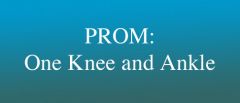
|

|
|
|
Explain procedure, speaking clearly, slowly, and directly, maintaining face-to-face contact whenever possible.
|
Perform Passive Range of Motion (PROM) For One Knee and One Ankle 1
|
|
|
Provide privacy with a curtain, screen, or door.
|
Perform Passive Range of Motion (PROM) For One Knee and One Ankle 2
|
|
|
Instruct client to inform you if pain is experienced during exercise.
|
Perform Passive Range of Motion (PROM) For One Knee and One Ankle 3
|
|
|
Support leg at knee and ankle while performing range of motion for knee
|
Perform Passive Range of Motion (PROM) For One Knee and One Ankle 4
|
|
|
Bend the knee and then return leg to client's normal position (extension-flexion) AT LEAST 3 TIMES unless pain is verbalized.
|
Perform Passive Range of Motion (PROM) For One Knee and One Ankle 5
|
|
|
Support foot and ankle close to the bed while performing range of motion for ankle.
|
Perform Passive Range of Motion (PROM) For One Knee and One Ankle 6
|
|
|
Push/pull foot toward head (dorsiflexion) and push/pull foot down with toes pointing down (plasar flexion) AT LEAST 3 TIMES unless pain is verbalized.
|
Perform Passive Range of Motion (PROM) For One Knee and One Ankle 7
|
|
|
Critical step: While supporting the limb, move joints gently, slowly, and smoothly through the range of motion, discontinuing exercise if client verbalizes pain.
|
Perform Passive Range of Motion (PROM) For One Knee and One Ankle 8
|
|
|
Ensure signaling device is within reach and bed is in low position.
|
Perform Passive Range of Motion (PROM) For One Knee and One Ankle 9
|
|
|
Wash hands.
|
Perform Passive Range of Motion (PROM) For One Knee and One Ankle 10
|
|

|

|
|
|
Explain procedure, speaking clearly, slowly, and directly, maintaining face-to-face contact whenever possible.
|
Perform Passive Range of Motion (PROM) For One Shoulder 1
|
|
|
Provide privacy with a curtain, screen, or door.
|
Perform Passive Range of Motion (PROM) For One Shoulder 2
|
|
|
Instruct client to inform you if pain is experienced during exercise.
|
Perform Passive Range of Motion (PROM) For One Shoulder 3
|
|
|
Support client's arm at elbow and wrist while performing range of motion for shoulder.
|
Perform Passive Range of Motion (PROM) For One Shoulder 4
|
|
|
Raise client's straightened arm from side position upward toward head to ear level and return down to side of body (extension-flexion) AT LEAST 3 TIMES unless pain is verbalized.
|
Perform Passive Range of Motion (PROM) For One Shoulder 5
|
|
|
Move client's straightened arm away from side of body to shoulder level and return to side of body (abduction-adduction) AT LEAST 3 TIMES unless pain is verbalized.
|
Perform Passive Range of Motion (PROM) For One Shoulder 6
|
|
|
Critical step: While supporting limb, move joint gently, slowly and smoothly through the range of motion, discontinuing exercise if client verbalizes pain.
|
Perform Passive Range of Motion (PROM) For One Shoulder 7
|
|
|
Ensure signaling device is within reach and bed is in low position.
|
Perform Passive Range of Motion (PROM) For One Shoulder 8
|
|
|
Wash hands.
|
Perform Passive Range of Motion (PROM) For One Shoulder 9
|
|

|

|
|
|
Explain procedure, speaking clearly, slowly, and directly, maintaining face-to-face contact whenever possible.
|
Position On Side 1
|
|
|
Provide privacy with a curtain, screen, or door.
|
Position On Side 2
|
|
|
Before turning, lower head of bed.
|
Position On Side 3
|
|
|
Raise side rail on side to which body will be turned.
|
Position On Side 4
|
|
|
Slowly roll onto side as one unit toward raised side rail.
|
Position On Side 5
|
|
|
Place or adjust pillow under foot for support.
|
Position On Side 6
|
|
|
Position client so that client is not lying on arm.
|
Position On Side 7
|
|
|
Support top arm with supportive device.
|
Position On Side 8
|
|
|
Place supportive device behind client's back.
|
Position On Side 9
|
|
|
Place supportive device between legs with top knee flexed; support knee and ankle.
|
Position On Side 10
|
|
|
Ensure signaling device is within reach and bed is in low position.
|
Position On Side 11
|
|
|
Wash hands.
|
Position On Side 12
|
|

|

|
|
|
Explain procedure, speaking clearly, slowly, and directly, maintaining face-to-face contact whenever possible.
|
Provide Catheter Care For Female 1
|
|
|
Provide privacy with a curtain, screen, or door.
|
Provide Catheter Care For Female 2
|
|
|
Before washing, check water temperature for safety and comfort and ask client to verify comfort of water.
|
Provide Catheter Care For Female 3
|
|
|
Put on clean gloves before washing.
|
Provide Catheter Care For Female 4
|
|
|
Place linen protector under perineal area before washing.
|
Provide Catheter Care For Female 5
|
|
|
Expose area surrounding catheter while avoiding overexposure of client.
|
Provide Catheter Care For Female 6
|
|
|
Apply soap to wet washcloth.
|
Provide Catheter Care For Female 7
|
|
|
Critical step 1: While holding catheter near meatus without tugging, clean at least four inches of catheter near meatus, using a clean area of the cloth for each stroke.
|
Provide Catheter Care For Female 8
|
|
|
Critical step 2: While holding catheter near meatus without tugging, rinse at least four inches of catheter near meatus, using a clean area of the cloth for each stroke.
|
Provide Catheter Care For Female 9
|
|
|
While holding catheter near meatus without tugging, dry four inches of catheter moving away from meatus.
|
Provide Catheter Care For Female 10
|
|
|
Empty, rinse and dry basin.
|
Provide Catheter Care For Female 11
|
|
|
After rinsing basin, place it in designated dirty supply area.
|
Provide Catheter Care For Female 12
|
|
|
Dispose of used linen into soiled linen container and dispose of linen protector appropriately.
|
Provide Catheter Care For Female 13
|
|
|
Avoid contact between your clothing and used linen.
|
Provide Catheter Care For Female 14
|
|
|
After disposing of used linen and cleaning equipment, remove and dispose of glove (without contaminating self) into waste container and wash hands.
|
Provide Catheter Care For Female 15
|
|
|
Ensure signaling device is within reach and bed is in low posiiton.
|
Provide Catheter Care For Female 16
|
|

|

|
|
|
Explain procedure, speaking clearly, slowly, and directly, maintaining face-to-face contact whenever possible.
|
Provide Foot Care On One Foot 1
|
|
|
Provide privacy with a curtain, screen, or door.
|
Provide Foot Care On One Foot 2
|
|
|
Before washing, check water temperature for safety and comfort and ask client to verify comfort of water.
|
Provide Foot Care On One Foot 3
|
|
|
Place basin in a comfortable position for client and on protective barrier.
|
Provide Foot Care On One Foot 4
|
|
|
Put on clean gloves before washing foot.
|
Provide Foot Care On One Foot 5
|
|
|
Place client's bare foot into basin.
|
Provide Foot Care On One Foot 6
|
|
|
Apply soap to wet washcloth.
|
Provide Foot Care On One Foot 7
|
|
|
Lift foot from water and wash it, including between the toes.
|
Provide Foot Care On One Foot 8
|
|
|
Rinse foot, including between toes.
|
Provide Foot Care On One Foot 9
|
|
|
Dry foot, including between toes.
|
Provide Foot Care On One Foot 10
|
|
|
Apply lotion to top and bottom of foot, removing excess (if any) with a towel.
|
Provide Foot Care On One Foot 11
|
|
|
Support foot and ankle during procedure.
|
Provide Foot Care On One Foot 12
|
|
|
Empty, rinse and dry basin.
|
Provide Foot Care On One Foot 13
|
|
|
After rinsing basin, place it in designated dirty supply area.
|
Provide Foot Care On One Foot 14
|
|
|
Dispose of used linen into soiled linen container.
|
Provide Foot Care On One Foot 15
|
|
|
After cleaning foot and equipment and disposing of linen, remove and dispose of glove (without contaminating self) into waste container and wash hands.
|
Provide Foot Care On One Foot 16
|
|
|
Ensure signaling device is within reach.
|
Provide Foot Care On One Foot 17
|
|

|

|
|
|
Explain procedure, speaking clearly, slowly, and directly, maintaining face-to-face contact whenever possible.
|
Provide Mouth Care 1
|
|
|
Provide privacy with a curtain, screen, or door.
|
Provide Mouth Care 2
|
|
|
Before providing mouth care, ensure client is in upright sitting position (45-90°).
|
Provide Mouth Care 3
|
|
|
Put on clean gloves before cleaning mouth.
|
Provide Mouth Care 4
|
|
|
Place clothing protector across chest before providing mouth care.
|
Provide Mouth Care 5
|
|
|
Moisten toothbrush.
|
Provide Mouth Care 6
|
|
|
Apply toothpaste to toothbrush.
|
Provide Mouth Care 7
|
|
|
Critical step: Clean mouth (including tongue and surfaces of teeth) using gentle motions.
|
Provide Mouth Care 8
|
|
|
Maintain clean technique with placement of tooth brush.
|
Provide Mouth Care 9
|
|
|
Hold emesis basin to chin while client rinses mouth.
|
Provide Mouth Care 10
|
|
|
Wipe mouth and remove clothing protector.
|
Provide Mouth Care 11
|
|
|
Empty, rinse and dry basin.
|
Provide Mouth Care 12
|
|
|
Place used toothbrush in basin.
|
Provide Mouth Care 13
|
|
|
After rinsing basin, place basin in designated dirty supply area.
|
Provide Mouth Care 14
|
|
|
Dispose of clothing protector appropriately.
|
Provide Mouth Care 15
|
|
|
After placing basin in designated dirty supply area and disposing of used linen, remove and dispose of glove (without contaminating self) into waste container and wash hands.
|
Provide Mouth Care 16
|
|
|
Ensure signaling device is within reach and bed is in low position.
|
Provide Mouth Care 17
|
|

|

|
|
|
Explain procedure, speaking clearly, slowly, and directly, maintaining face-to-face contact whenever possible.
|
Provide Perineal Care (Peri-Care) For Female 1
|
|
|
Provide privacy with a curtain, screen, or door.
|
Provide Perineal Care (Peri-Care) For Female 2
|
|
|
Before washing, check water temperature for safety and comfort and ask client to verify comfort of water.
|
Provide Perineal Care (Peri-Care) For Female 3
|
|
|
Before washing, put on clean gloves.
|
Provide Perineal Care (Peri-Care) For Female 4
|
|
|
Before washing, place pad/linen protector under perineal area.
|
Provide Perineal Care (Peri-Care) For Female 5
|
|
|
Expose perineal area while avoiding overexposure of client.
|
Provide Perineal Care (Peri-Care) For Female 6
|
|
|
Apply soap to wet washcloth.
|
Provide Perineal Care (Peri-Care) For Female 7
|
|
|
Critical step 1: Wash genital area, moving from front to back, while using a clean area of washcoth for each stroke.
|
Provide Perineal Care (Peri-Care) For Female 8
|
|
|
Critical step 2: Using clean washcloth, rinse soap from genital area, moving from front to back, while using a clean area of washcoth for each stroke.
|
Provide Perineal Care (Peri-Care) For Female 9
|
|
|
Dry genital area moving from front to back with towel.
|
Provide Perineal Care (Peri-Care) For Female 10
|
|
|
After washing genital area, turn client to side then wash and rinse rectal area using a clean area of washcloth for each stroke. Dry with towel.
|
Provide Perineal Care (Peri-Care) For Female 11
|
|
|
Reposition client.
|
Provide Perineal Care (Peri-Care) For Female 12
|
|
|
Empty, rinse and dry basin.
|
Provide Perineal Care (Peri-Care) For Female 13
|
|
|
After rinsing basin, place it in designated dirty supply area.
|
Provide Perineal Care (Peri-Care) For Female 14
|
|
|
Dispose of used linen into soiled linen container and dispose of linen protector appropriately.
|
Provide Perineal Care (Peri-Care) For Female 15
|
|
|
Avoid contact between your clothing and used linen.
|
Provide Perineal Care (Peri-Care) For Female 16
|
|
|
After disposing of linen and placing used equipment in designated dirty supply area, remove and dispose of glove (without contaminating self) into waste container and wash hands.
|
Provide Perineal Care (Peri-Care) For Female 17
|
|
|
Ensure signaling device is within reach and bed is in low position.
|
Provide Perineal Care (Peri-Care) For Female 18
|
|

|

|
|
|
Explain procedure, speaking clearly, slowly, and directly, maintaining face-to-face contact whenever possible.
|
Transfer From Bed to Wheelchair Using Transfer Belt 1
|
|
|
Provide privacy with a curtain, screen, or door.
|
Transfer From Bed to Wheelchair Using Transfer Belt 2
|
|
|
Before assisting to stand, position wheelchair along side of bed, at head of bed, and facing the foot of bed.
|
Transfer From Bed to Wheelchair Using Transfer Belt 3
|
|
|
Before assisting to stand, fold up footrests or remove them.
|
Transfer From Bed to Wheelchair Using Transfer Belt 4
|
|
|
Before assisting to stand, ensure bed is at a safe level.
|
Transfer From Bed to Wheelchair Using Transfer Belt 5
|
|
|
Critical step: Before assisting to stand, lock wheels on wheelchair.
|
Transfer From Bed to Wheelchair Using Transfer Belt 6
|
|
|
Before assisting to stand, check and/or lock bed wheels.
|
Transfer From Bed to Wheelchair Using Transfer Belt 7
|
|
|
Before assisting to stand, assist client to a sitting position with feet flat on floor.
|
Transfer From Bed to Wheelchair Using Transfer Belt 8
|
|
|
Before assisting to stand, ensure client is wearing shoes.
|
Transfer From Bed to Wheelchair Using Transfer Belt 9
|
|
|
Before assisting to stand, apply transfer belt securely over clothing/gown.
|
Transfer From Bed to Wheelchair Using Transfer Belt 10
|
|
|
Before assisting to stand, provide instructions to enable client to assist in transfer including prearranged signal to alert when to begin standing.
|
Transfer From Bed to Wheelchair Using Transfer Belt 11
|
|
|
Stand facing client, positioning self to ensure safety of self and client during transfer. Count to three or say other prearranged signal to alert client to begin standing.
|
Transfer From Bed to Wheelchair Using Transfer Belt 12
|
|
|
On signal, gradually assist client to stand by grasping transfer belt on both sides with an upward grasp, with your hands in upright position, and maintain stability of client's legs.
|
Transfer From Bed to Wheelchair Using Transfer Belt 13
|
|
|
Assist client to turn to stand in front of wheelchair with back of client's legs against wheelchair.
|
Transfer From Bed to Wheelchair Using Transfer Belt 14
|
|
|
Lower client into wheelchair.
|
Transfer From Bed to Wheelchair Using Transfer Belt 15
|
|
|
Position client with hips touching back of wheelchair and remove transfer belt.
|
Transfer From Bed to Wheelchair Using Transfer Belt 16
|
|
|
Position feet on footrests.
|
Transfer From Bed to Wheelchair Using Transfer Belt 17
|
|
|
Ensure signaling device is within reach.
|
Transfer From Bed to Wheelchair Using Transfer Belt 18
|
|
|
Wash hands.
|
Transfer From Bed to Wheelchair Using Transfer Belt 19
|
|

|
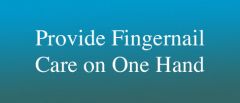
|
|
|
Explain procedure, speaking clearly, slowly, and directly, maintaining face-to-face contact whenever possible.
|
Provide Fingernail Care on One Hand 1
|
|
|
Before immersing fingernails, check water temperature for safety and comfort and ask client to verify comfort of water.
|
Provide Fingernail Care on One Hand 2
|
|
|
Place basin in comfortable position for client.
|
Provide Fingernail Care on One Hand 3
|
|
|
Before cleaning fingernails, put on clean gloves.
|
Provide Fingernail Care on One Hand 4
|
|
|
Immerse fingernails in basin of water.
|
Provide Fingernail Care on One Hand 5
|
|
|
Clean under each fingernail with orangewood stick.
|
Provide Fingernail Care on One Hand 6
|
|
|
Wipe orangewood stick on towel after each nail.
|
Provide Fingernail Care on One Hand 7
|
|
|
Dry fingernail area.
|
Provide Fingernail Care on One Hand 8
|
|
|
Feel each nail and file as needed.
|
Provide Fingernail Care on One Hand 9
|
|
|
Dispose of orangewood stick and emery board into waste container (for testing purposes).
|
Provide Fingernail Care on One Hand 10
|
|
|
Empty, rinse and dry basin.
|
Provide Fingernail Care on One Hand 11
|
|
|
After rinsing basin, place it in designated dirty supply area.
|
Provide Fingernail Care on One Hand 12
|
|
|
Dispose of used linen into soiled linen container.
|
Provide Fingernail Care on One Hand 13
|
|
|
After cleaning nails and equipment and disposing of soiled linen, remove and dispose of glove (without contaminating self) into waste container and wash hands.
|
Provide Fingernail Care on One Hand 14
|
|
|
Ensure signaling device is within reach.
|
Provide Fingernail Care on One Hand 15
|

